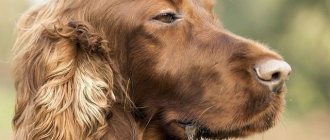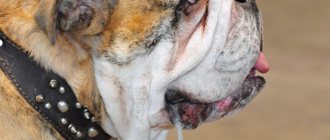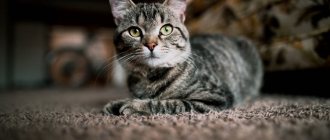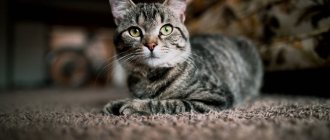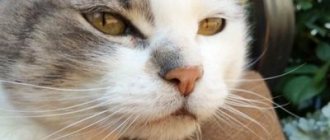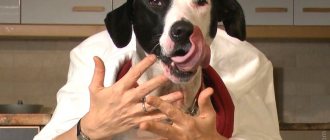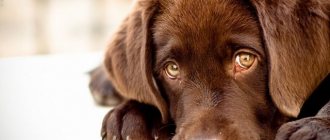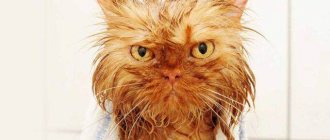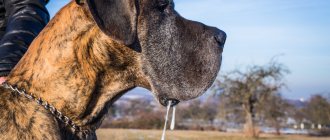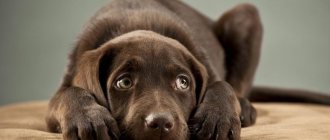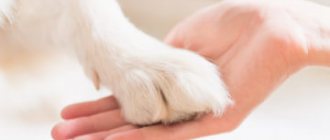Dogs have lived next to humans for more than 10 thousand years. During this time, people artificially bred about 400 breeds, from tiny indoor breeds to massive utility breeds. Dogs of different breeds have a wide range of physiological characteristics, including a tendency to salivate.
The secretion of the salivary glands, natural for all mammals, performs important functions in the animal’s body - it forms protection for the oral cavity from the penetration of pathogenic bacteria, promotes more thorough digestion and absorption of food, moisturizing and softening it. But it also happens that copious secretion of the salivary glands and hypersalivation signal problems with the pet’s health.
There are a number of dog breeds for which hypersalivation is a natural function, determined by the peculiarities of the anatomical structure - a massive head with a shortened jaw, loose jowls. These include Great Danes, Boxers, Bulldogs, Shar-Peis, Mastiffs, Newfoundlands, St. Bernards, and Caucasian Shepherds.
If your dog is drooling, it may be a natural physiological manifestation. The following reasons for excessive salivation are considered normal:
- On a hot day, the animal’s body exhibits a protective reaction to overheating;
- High physical activity;
- Natural reaction to the smell of food;
- In females during pregnancy;
- In puppies when changing teeth;
- Response to drug intervention.
It should be taken into account that, according to the observations of doctors, saliva production in a volume of no more than 1 liter per day is considered normal. If your dog is constantly drooling too much, the reason may be pathological changes or the presence of diseases. Especially if salivation is accompanied by other alarming symptoms.
Content
1. The role of saliva 2. Why does a dog drool 3. Pathogenic causes 4. How to recognize increased drooling 5. What should the pet owner do 6. Diagnosis and treatment 7. Diagnosis of oral pathologies 8. Prevention of increased drooling
The phenomenon when a dog drools from its mouth is called hypersalivation. Synonyms for excessive drooling are ptyalism, sialorrhea. Whatever the reason for this condition, an attentive owner will try to figure it out and help the pet. His correct and timely actions can even prevent the development of an impending pathology.
When to contact a veterinarian?
Any changes in the well-being, health and behavior of your four-legged pet are a reason to contact a veterinary clinic. Unfortunately, it is very easy to miss the development of a dangerous disease in dogs. As soon as the dog owner notices drastic changes, we recommend that you immediately go to the doctor.
Should you always see a doctor?
Contacting a specialist can be delayed if the owner has identified the origin of the increase in discharge as physiological causes or anatomical structure.
The role of saliva
Saliva is a vital serous-mucosal secretion secreted by 3 pairs of large and several small glands located in the dog’s mouth. Its functions:
- moisturizes the oral mucosa;
- promotes the recognition of the taste of food and the production of gastric juice;
- facilitates the passage of food into the stomach;
- improves food digestion;
- neutralizes and removes toxins.
Antimicrobial substances in saliva help disinfect wounds, which is why they say: “heals like a dog.”
Why does a dog drool?
The amount of secretion secreted depends on feeding characteristics, but not only. There are 3 types of reasons why saliva may flow: physiological, psychological and pathogenic.
The first 2 types cause temporary hypersalivation. It goes away when the provoking factor is eliminated. For example, a hungry dog smells food. Olfactory receptors send a signal to the salivation center located in the brain, and the secretion of the salivary glands begins to be actively produced. A well-fed animal does not react this way to food, although the sight of its favorite treat makes all pets salivate.
Ptyalism is provoked by irritation of taste buds with bitter, sour, unpleasant foods, and medications. Thirst in hot weather and getting sand in your mouth will also cause drooling.
Motion sickness in transport can become a serious problem. Dogs that cannot tolerate shaking due to problems with the vestibular system begin to leak foamy liquid profusely during a car ride, even to the point of vomiting. If this property does not go away over time, drugs that prevent motion sickness are used.
Drooling may occur in hunting breeds due to physical fatigue, and in 3-4 month old puppies due to teething. Another physiological factor is associated with pleasure, when the owner’s caresses are extremely pleasant.
Psychological reasons include various types of stress, fear, and anticipation of danger. Hypersalivation can be caused by loud sounds, a meeting with an enemy, a change in familiar surroundings, or a long absence of the owners.
Attention!
Excessive drooling caused by physiological and psychological reasons is not dangerous for the dog - which is why it should not cause alarm to the owner.
Pathogenic causes
If so much saliva is produced that it drains from the jaw, the animal is forced to constantly swallow it, therefore, the cause of sialorrhea is a disease or other pathological condition of the body.
Provoking factors:
- Viral diseases. Excessive salivation is accompanied by fever, cough, increased thirst, gag reflex, and an unpleasant odor from the mouth may be felt.
- Ear pathologies. This is due to the fact that one of the large salivary glands is located in the parotid region.
- Poisoning caused by drugs, pesticides, poisonous plants, spoiled food. The dog not only drools, but the contents of the stomach vomit out.
- Gastrointestinal diseases. Pathologies of the liver, spleen, and cholelithiasis cause nausea and vomiting, which are accompanied by increased salivation. In this case, a putrid odor may emanate from the mouth. Possible loose stools or constipation.
- Pathologies of the oral cavity. These include: stomatitis, gum disease, caries. Drool hangs from the mouth if a foreign body is stuck between the teeth. The assumption will be confirmed if the pet does not eat, does not drink, or even refuses treats because it hurts to chew.
- Infection with worms. Helminths in the small intestine cause intoxication of the body, which becomes the cause of ptyalism.
- Allergic reactions of any etiology.
- Disorders of the functions of the nerves that transmit impulses to the salivary glands.
- Epileptic seizures. Drooling in this case portends the approach of an attack.
- Stones in the ducts of the salivary glands (sialolithiasis). In this case, the viscous mucus hangs in strands.
- Malocclusion. Saliva flows due to constant trauma by teeth to the gums and tongue.
Finally, hypersalivation is a frequent accompaniment of pain that exhausts the dog.
Important!
Dangerous infectious diseases - rabies, botulism - are also one of the reasons.
Poisoning
Saliva has buffering properties that allow it to neutralize the burning effect of acids, alkalis, other aggressive substances, as well as toxins. Dogs can become poisoned in the following situations:
- Eating spoiled foods.
- Unqualified use of medications or feed additives.
- Access to trash can, household items, household chemicals.
- Eating food not intended for dogs - scraps of human food, chocolate, fatty meat, salty, smoked foods.
In this case, thickening of saliva, hyperthermia, thirst, pallor of mucous membranes, diarrhea, and vomiting are observed. First aid consists of the use of sorbents - Enterosgel or Smecta. If there is no therapeutic effect, you must seek veterinary help.
What is the cause of drooling?
How to recognize increased drooling
The secretory activity of the salivary glands occurs periodically and is associated with food intake. Normally, depending on the breed of the dog, about 1 liter of biological fluid is released. The dog swallows it and does not “drool” unless there are reasons stated above. However, there are “slobbery” breeds, including:
- boxers;
- mastiffs;
- Saint Bernards;
- Shar-Pei;
- Great Danes;
- bloodhounds;
- English, French and continental bulldogs.
In these breeds, sialorrhea is caused by drooping cheeks or jaw structure that does not close completely.
Which breeds are more susceptible
In representatives of some breeds, hypersalivation is due to peculiarities of the anatomical structure. These are dogs with massive muzzles, loose, fleshy jowls and shortened jaws:
- Shar-Pei;
- Maltese;
- bulldogs;
- boxers;
- Saint Bernards;
- Newfoundlands;
- mastiffs,
- Great Danes;
- Caucasian Shepherd Dogs;
- bloodhounds.
These dogs drool for any reason: in cold or hot weather, before eating, out of joy or excitement. You can often notice saliva on them during sleep. The phenomenon, which is called false ptyalism, is not considered a serious fault of the breed, but many breeders try to prevent dogs that are too “loose” from being bred.
When choosing a puppy, it is advisable to pay attention to its parents. If they are constantly slobbering and getting everything dirty, then their babies will be the same. In this case, all that remains is to accept it and constantly wipe the dog’s face.
What should a pet owner do?
If hypersalivation begins in a pet that is not a breed with natural profuse salivation, the owner should carefully examine his four-legged friend and analyze the situation. Perhaps the animal is experiencing stress, then it needs to be given more attention.
Sometimes, while walking, a dog may eat a non-food product or a small rodent, then the mouth needs to be rinsed. In this case, salivation is a protective reaction: it removes harmful substances.
If there are no visible injuries, there is no foreign body in the mouth, and the owner cannot determine the reason why saliva is flowing, you need to consult a doctor. You should not postpone a visit to the veterinary hospital if there are signs of poisoning or an infectious disease: vomiting, diarrhea, refusal to eat, dry, hot nose.
About preventing excessive salivation
The most effective preventive measure is timely vaccination of the animal. The main preventive measures also include sanitary standards for keeping dogs, feeding hygiene, and regular antiparasitic procedures. It is important to limit your pet’s contact with stray animals as much as possible. If you notice persistent excessive salivation in your dog, you should immediately contact your veterinarian. A timely diagnosis and prompt medical care significantly increase the chances of a full recovery.
Diagnosis and treatment
The occurrence of hypersalivation is a signal that something wrong is happening to the dog. To help a pet, the owner must know the symptoms of pathologies that cause excessive saliva flow.
If a dog loses its appetite, loses weight, or has abnormal bowel movements, this may be a sign of helminthiasis. In this case, you need to be tested for worms and undergo treatment with an anthelmintic drug prescribed by a veterinarian.
If a dog has lost consciousness, is shaking, has convulsions, and has foamy saliva coming out of its mouth – these are symptoms of an epileptic seizure.
When poisoned, the dog constantly licks its face and worries. Frequent belching is observed, rumbling in the stomach is periodically heard, and diarrhea may begin. First aid is to give activated carbon or other absorbents. The animal is provided with plenty of fluids and is not allowed to eat for 24 hours. If symptoms do not disappear and a fever appears, medical attention will be required.
Symptoms of rabies include restlessness, lethargy, and hydrophobia. The pet is shaking, has difficulty swallowing, and has vomiting and diarrhea. An animal with such signs is immediately isolated and the veterinarian is informed. The dog's further fate is euthanasia.
First aid
If, however, preventive measures did not help, and it so happened that the dog began to actively salivate, and the process is accompanied by other symptoms, you should immediately respond to the situation.
You need to follow the dog for some time and record the main points. If salivation is increased without other factors, you need to contact a veterinary clinic and report your observations.
In any case, the doctor can determine the disease based on symptoms and external observations, and then prescribe certain tests and treatment.
If the dog is seasick and the process of hypersalivation is a consequence of this, you need to give the pet sedatives. If you suspect poisoning, give him plenty of fluids, provide him with rest, and the next day make sure that the animal is fasting.
Diagnosis of oral pathologies
Stomatitis is a common pathology that causes excessive saliva flow. It hurts the dog to chew, which is why it refuses solid food, chooses soft food, eats carefully and slowly, with stops.
There are such forms of stomatitis:
- Catarrhal. The oral mucosa is swollen, hyperemic in places, and covered with plaque. Treatment consists of treating the oral cavity with furatsilin, a pale pink solution of potassium permanganate, a 3% solution of boric acid, and decoctions of medicinal herbs. Food - broths, liquid porridges, dairy products, jelly.
- Ulcerative. Ulcerations form on the tongue and oral mucosa. For treatment, a mixture of iodine and glycerin (1:4), lapis, and syntomycin emulsion are used. Antibiotics are prescribed if necessary.
- Atrophic. Diagnosed in emaciated and old dogs. Vesicles, bleeding wounds, and ulcers are found on the inflamed mucosa.
With stomatitis, a putrid odor emanates from the mouth. In severe cases, there is an increase in temperature, lethargy and apathy of the animal.
When a foreign object gets stuck in the mouth, symptoms similar to stomatitis appear. There may be drops of blood in the saliva if the mucous membrane is injured. In this case, you need to remove the object and treat the wound with a disinfectant solution.
It's worse if the bone gets stuck in the throat. The dog has difficulty breathing, he constantly rubs his face with his paw, and he begins to vomit. You need to act quickly and carefully so as not to push the fragment into the esophagus. You can use tweezers and a flashlight.
With dental caries, there is a painful reaction to chewing food. The dog chews on one side of his teeth. He reacts painfully to tapping on a sore tooth, in which a dark-colored depression is noticeable. Treatment is carried out only in a veterinary hospital.
